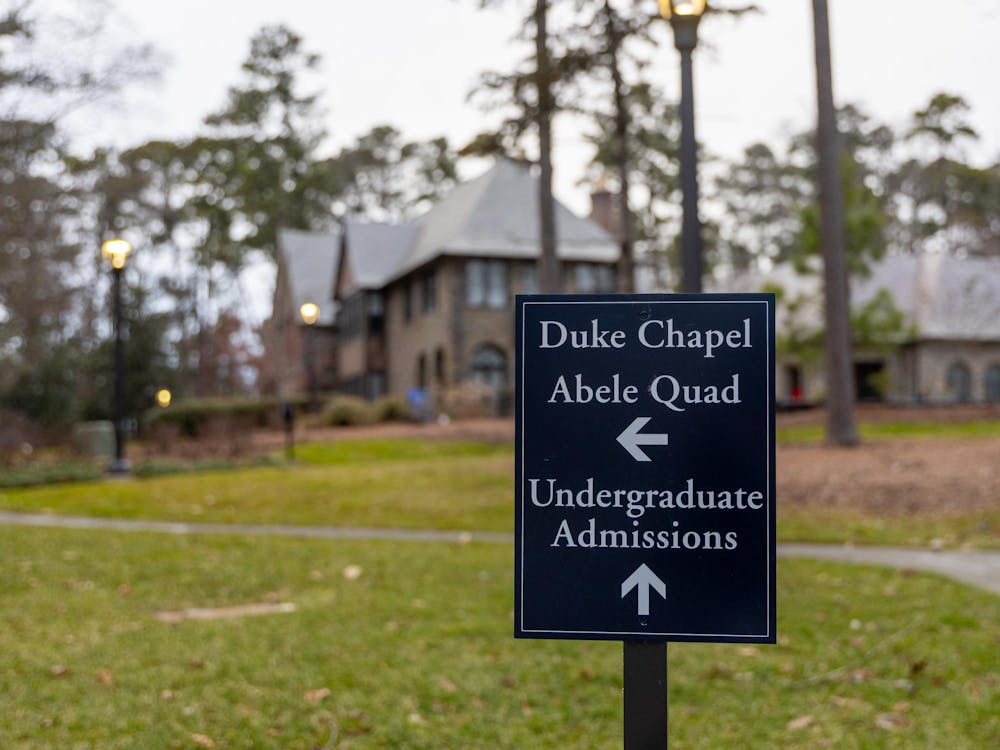Duke admitted a record-low 4.8% of applicants to the Class of 2029 this admission cycle. To put the University’s selectivity into context, The Chronicle compared Duke’s Early Decision, Regular Decision and overall acceptance statistics with the 14 peer institutions in the Ivy+ grouping.
Certain Ivy+ schools, including the California Institute of Technology, Cornell University, Harvard University, Princeton University, Stanford University and the University of Chicago, chose not to disclose their admissions rate alongside the release of admissions results and therefore are not included in the comparison.
All Ivy League institutions that disclosed their data saw an increase in overall acceptance rates, and all but one saw a drop in applications. Non-Ivy-League peer institutions had more variable statistics.
Duke University
Duke accepted 12.8% of Early Decision applicants to the Class of 2029, offering admission to 849 out of 6,627 high school seniors. A record-high 113 were admitted through the QuestBridge National College Match Program, which provides low-income students with full-ride scholarships to a variety of partner institutions across the country.
During the Regular Decision cycle, which received an all-time high of 53,223 applicants, the University welcomed 1,953 students to the Class of 2029 for a record-low 3.67% acceptance rate.
The overall 4.8% acceptance rate marks a decrease of 0.3% from last year’s 5.1% overall acceptance rate.
Ivy League
Brown University
Brown University offered admission to 2,418 students, marking an increase in its acceptance rate from 5.2% last year to 5.65%. The Class of 2029 acceptance rate is the highest that the university has seen since the Class of 2024.
The Regular Decision acceptance rate rose from 3.8% to 4%, and the Early Decision acceptance rate increased nearly 4 percentage points, from 14.4% to 18%. The rising rates were accompanied by a significant drop in application numbers, with a total of 42,765 applicants — the smallest number since the Class of 2024 and a 12.55% drop from last year.
Columbia University
Columbia admitted 4.29% of all applicants this year, an increase from the Class of 2028’s acceptance rate of 3.85% and the highest acceptance rate at the university in five years. Columbia did not distinguish between the number of applicants admitted in the Early Decision and Regular Decision cycles.
Application numbers slightly declined this year from 60,248 to 59,616. This decrease follows significant turmoil at Columbia, including the arrests of pro-Palestinian student protesters last spring and the resignation of former President Minouche Shafik for how her administration handled student protests, academic freedom and antisemitism on campus.
Dartmouth College
Dartmouth accepted 6% of applicants vying for a spot in the Class of 2029, an increase from last year’s 5.3%. Like Columbia, Dartmouth did not separately indicate how many applicants were accepted in each admission cycle.
Similar to other Ivy League institutions, Dartmouth’s increased acceptance rate was accompanied by a drop in application numbers. The college experienced an almost 11% decrease in applicants this year.
University of Pennsylvania
While UPenn did not share its acceptance rates, the university did disclose that unlike other Ivy League institutions, it witnessed a significant increase in applications from over 65,000 last year to more than 72,000 this year. This marks the University’s largest applicant pool ever.
Yale University
Get The Chronicle straight to your inbox
Sign up for our weekly newsletter. Cancel at any time.
Yale offered admission to 2,308 students this year, yielding an acceptance rate of 4.59%, its highest in four years. Last year, the university accepted a record-low 3.73% of applicants. Yale had previously announced that it would be increasing its undergraduate class size by 100 students beginning in the Class of 2029 admissions cycle.
The Regular Decision acceptance rate rose from 2.75% to 3.65%, while Yale’s single-choice Early Action acceptance rate increased from 9.02% to 10.82%. While the applicant pool was the third largest in Yale’s history at 50,227 applications, it was still 12% less than the previous year.
‘Plus’ schools
Johns Hopkins University
Johns Hopkins saw a Regular Decision acceptance rate of 4.16%, down from 6.2% in the previous year.
The university did not report its overall acceptance rate or the total number of applications, though it did disclose that 41,549 students applied during the Regular Decision cycle and that the total number of applicants increased by 8.8% from last year.
Massachusetts Institute of Technology
MIT held a steady 4.5% acceptance rate for the Class of 2029 — the same percentage as last year. However, rates fluctuated within each decision cycle. MIT’s Early Action acceptance rate increased from 5.3% to 6.0%, while its Regular Action acceptance rate decreased from 2.6% to 2.4%.
MIT saw a 3.72% increase in its total number of applications from 28,232 in the 2023-24 cycle to 29,282 in the 2024-25 cycle. In line with acceptance rate statistics, the number of Early Action applications decreased by 4.1%, while the number of Regular Action applications increased by 9.96%.
Northwestern University
Like Duke, Northwestern saw a decrease in its acceptance rate to just over 7%, below last year’s rate of 7.6% and close to the university’s record low of 6.97%. The Early Decision acceptance rate stayed roughly consistent with prior years at around 20%, meaning the Regular Decision acceptance rate likely decreased, although the exact percentage was not disclosed.
Northwestern also saw its largest applicant pool ever, with over 53,000 applications, up from last year’s approximate 50,000. This included a 15.5% increase in Early Decision applications, with just over 6,000 submissions.
Dylan Halper is a Trinity first-year and university news editor for the news department.

